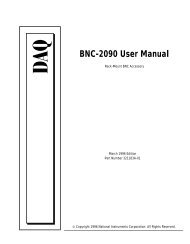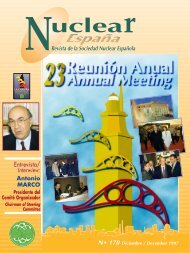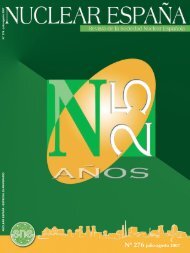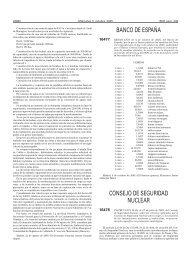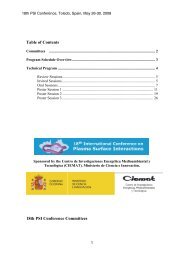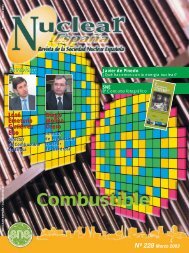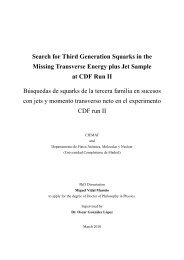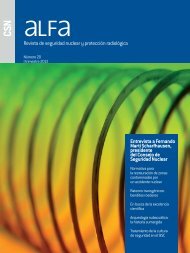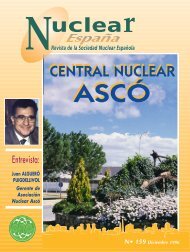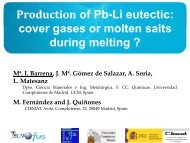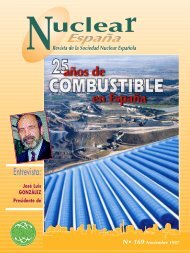EntrEntr evista/evista/ InterInter viewview
EntrEntr evista/evista/ InterInter viewview
EntrEntr evista/evista/ InterInter viewview
You also want an ePaper? Increase the reach of your titles
YUMPU automatically turns print PDFs into web optimized ePapers that Google loves.
CENTRALES NUCLEARES/NUCLEAR POWER PLANTS<br />
Gw.h<br />
9000<br />
8000<br />
7000<br />
6000<br />
5000<br />
4000<br />
3000<br />
2000<br />
1000<br />
0<br />
PRODUCCIÓN BRUTA DE ENERGÍA ELÉCTRICA /<br />
GROSS ELECTRIC ENERGY PRODUCTION<br />
6833<br />
7173 7303 7358 7311<br />
6398 6929 7172 7418 7318 7338 7276 8028 7264 7261 8484 7971 7163<br />
1985 1986 1987 1988 1989 1990 1991 1992 1993 1994 1995 1996 1997<br />
PRODUCCIÓN ANUAL/ANNUAL PRODUCTION<br />
baja de residuos en un año con<br />
Recarga. Comparando los resultados<br />
respecto a 1996, año en que tuvimos<br />
la última Recarga de corta duración<br />
(6 días menos que ésta última)<br />
hemos reducido un 16% la<br />
producción de residuos.<br />
Entre las actuaciones de este Plan<br />
de Reducción de Residuos, en 1999<br />
se ha concluido el primer año de<br />
funcionamiento del Equipo de<br />
Secado de Residuos mediante el<br />
cual se han producido un total de<br />
16 bidones acondicionados, lo cual<br />
ha supuesto un ahorro de 100 bidones<br />
frente a la producción estimada<br />
con la técnica convencional de cementación.<br />
Así mismo, hemos instalado cartuchos<br />
filtrantes de longitud extendida<br />
en los últimos tres filtros del sistema<br />
de Purificación de<br />
Condensado, completando las actuaciones<br />
en este sistema.<br />
Cabe destacar también, dentro de<br />
las modificaciones implantadas en<br />
1999, la realizada en la planta de<br />
solidificación de residuos, que ha<br />
supuesto la mejora en los procesos<br />
de dosificación de residuo y cemento<br />
y la del proceso de mezcla en el<br />
bidón.<br />
En el Almacén Temporal de<br />
Bidones se ha reducido su ocupación<br />
al 40% por lo que cada vez<br />
disponemos de mayor capacidad de<br />
almacenamiento, debido al programa<br />
de retirada de bidones establecido<br />
con Enresa, que el pasado año<br />
trasladó a El Cabril 2260 bultos.<br />
En cuanto al almacenamiento de<br />
combustible gastado, recordar que<br />
Cofrentes dispone de dos piscinas<br />
con 4.190 posiciones libres, que expresado<br />
en años, nos permitirá almacenar<br />
combustible en la Central<br />
hasta el año 2015.<br />
7547 7523 7518 7670<br />
Años/Years<br />
7905 7873 7869<br />
8473<br />
1998<br />
7803<br />
7772<br />
1999<br />
MEDIA TRIENAL/TRIENNIAL AVERAGE<br />
FUNCIONAMIENTO DE LOS<br />
SISTEMAS DE SEGURIDAD<br />
El número de Sucesos Notificables<br />
al organismo regulador durante<br />
1999 ha sido de cinco, sin que<br />
ninguno de ellos haya supuesto incidencia<br />
radiológica para las personas<br />
o el medio ambiente.<br />
Para no extenderme en exceso,<br />
cuatro de los cinco sucesos se produjeron<br />
como consecuencia de la<br />
realización de pruebas contempladas<br />
en los procedimientos de operación,<br />
mientras que el quinto y último<br />
de estos se debió a la aparición<br />
de una alarma de Baja Escala en el<br />
monitor de radiación D17-K625A<br />
de la descarga del HVAC del<br />
Edificio Auxiliar, provocando su aislamiento<br />
y el arranque de los dos<br />
trenes del SGTS. La incidencia tuvo<br />
una duración de 4 minutos.<br />
Todo esto ha sido posible gracias<br />
a que el comportamiento de los sistemas<br />
de seguridad ha sido plenamente<br />
satisfactorio.<br />
EFECTO 2000<br />
Creo que en este momento es de<br />
todos conocido, expertos y público<br />
en general, que las temidas consecuencias<br />
del “Efecto 2000” no han<br />
sido, afortunadamente tales. En<br />
cualquier caso también quiero dejar<br />
claro que no hemos dejado nada al<br />
azar y buena prueba de ello es que<br />
en C.N. Cofrentes comenzamos a<br />
trabajar sobre este tema en 1997 en<br />
el denominado “Proyecto Año<br />
2000”, con el fin de asegurar que<br />
no se produciría ninguna incidencia<br />
operativa y que todos los sistemas<br />
informáticos susceptibles de la más<br />
mínima perturbación serían analizados<br />
y corregidos hasta donde fuera<br />
RADIOACTIVE WASTE<br />
With implementation of the Radioactive Waste<br />
Reduction Plan that includes the use of the most<br />
modern, effective waste treatment and management<br />
techniques, we have managed to significantly<br />
reduce waste generation, to the extent that in 1999<br />
the 137.5 m3 that we processed (625 drums)<br />
historically represent the lowest waste production in<br />
a year with refueling. If compared to the 1996<br />
results, the year in which we had the last short<br />
Refueling (6 days less than this last one), we have<br />
reduced waste production by 16%.<br />
Of the actions undertaken as part of this Waste<br />
Reduction Plan, 1999 marked the completion of the<br />
first year of operation of the Waste Drying<br />
Equipment, with which a total of 16 treated drums<br />
were produced, which amounts to a reduction of<br />
100 drums compared to estimated production with<br />
the conventional cementation technique.<br />
In addition, we have installed extended-length<br />
filtering cartridges in the last three filters of the<br />
Condensate Filtering system, thus completing the<br />
work on this system.<br />
The modifications implemented in 1999 included<br />
the one made in the waste solidification system,<br />
which has improved the waste and cement dosing<br />
processes and the drum mixing process.<br />
Occupation of the Temporary Drum Storage has<br />
been reduced by 40% thanks to the drum removal<br />
program established with ENRESA, which last year<br />
transferred 2260 packages to El Cabril. As a result,<br />
our storage capacity is growing.<br />
As regards spent fuel storage, Cofrentes has two<br />
pools with 4,190 free positions, which expressed in<br />
years means that we will be able to store fuel in the<br />
Plant until the year 2015.<br />
SAFETY SYSTEM OPERATION<br />
There were five Reportable Events to the<br />
regulatory body during 1999, though none of them<br />
involved any radiological incidence on people or the<br />
environment.<br />
Briefly, four of the five events occurred as a result<br />
of the testing required by the operating procedures,<br />
whereas the fifth and last event was due to a Low<br />
Scale alarm in radiation monitor D17-K625A of the<br />
Auxiliary Building HVAC discharge, causing its<br />
isolation and startup of the two SGTS trains. The<br />
incident lasted for 4 minutes.<br />
All this was possible thanks to the fully satisfactory<br />
performance of the safety systems.<br />
Y2K EFFECT<br />
I think that by now everyone, including experts<br />
and the general public, knows that the dreaded<br />
consequences of the “Y2K effect” have fortunately<br />
not materialized. In any event, I would like to make<br />
very clear that we left nothing to chance, and<br />
evidence of this is that in Cofrentes NPP we began to<br />
work on this issue in 1997 in the so-called “Y2K<br />
Project”, in order to ensure that no operating<br />
incident would occur and that all computer systems<br />
likely to suffer even the very slightest disturbance<br />
would be analyzed and corrected to the extent<br />
required for the Plant to continue operating with<br />
safety fully guaranteed.<br />
During the project, the Plant faithfully fulfilled all<br />
Consejo de Seguridad Nuclear requirements<br />
regarding multiple Plant inspections and audits in<br />
the months leading up the end of 1999, with<br />
permanent tracking of the entire project<br />
implementation program.<br />
In short, we reviewed 273 computer applications,<br />
equipment and systems, 15 people from the Plant’s<br />
staff were permanently involved in the project, and<br />
we invested 107 million pesetas (without counting<br />
A b r i l 2 0 0 0<br />
R e v i s t a S N E




